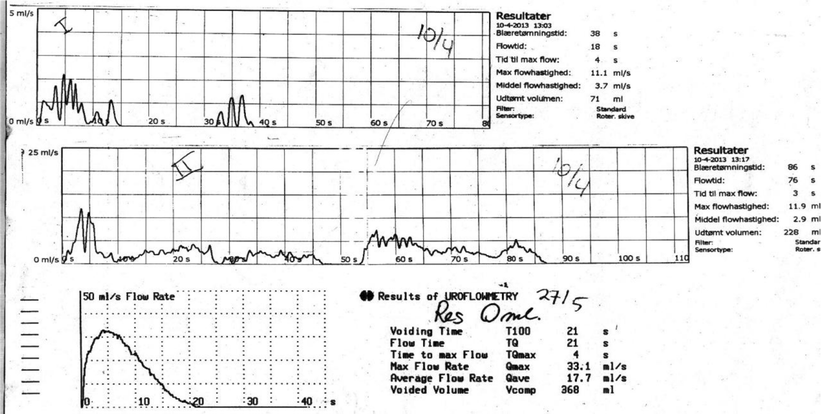
Journal: Journal of Parkinson's Disease, vol. Keywords: Parkinson’s disease, multiple system atrophy, progressive supranuclear palsy, urinary dysfunction, post-void residual urine Voiding dysfunction is associated with not only end organ damage, but also other nonmotor dysfunctions and patient activities of daily living. Post-void residual urine volume was significantly related to subjective urinary and other autonomic dysfunctions. Conclusion:Increased post-void residual urine volumes were observed in small portion of early drug-naïve Parkinsonian patients, especially in MSA. Post-void residual urine volume was positively related to autonomic symptoms, other non-motor symptoms, patient activities of daily living, and negatively related to renal function. Symptoms of the sense of incomplete emptying, weak urine stream, and nocturia were strongly correlated with post-void residual urine volume.
#Abnormal post void residual volume psp#
The MSA group showed significantly higher post-void residual urine volume compared to the PD and PSP groups. Results:Seventeen out of 196 parkinsonian patients showed abnormal post-void residual urine volumes, with ≥100 ml. Postpartum urinary retention (PUR) is defined as inability to void after six hours from delivery or having abnormal post-void residual volume after delivery (PVRV). All patients were also assessed on motor symptom severity, cognitive and affective measurements, other nonmotor symptoms, 39-item Parkinson’s Disease Questionnaire, and renal functions. For all subjects, data were collected on sonographic post-void residual urine volume and urinary symptoms. Methods:A total of 196 patients with de novo Parkinsonism without urological and gynecological disorders were included. Objective:To determine the correlation between subjective urinary dysfunction and post-void residual urine volume in patients with Parkinso n’s disease (PD), multiple system atrophy (MSA) and progressive supranuclear palsy (PSP), and to assess the relationship between clinical characteristics and subjective or objective urinary dysfunction. Ībstract: Background:Urinary dysfunction is relatively common, however, is often underestimated and diagnosed by subjective questionnaires in patients with Parkinsonism. Mary’s Hospital, 222, Banpo-daero, Seocho-gu, Seoul, 06591 Republic of Korea. | Department of Urology, College of Medicine, The Catholic University of Korea, Seoul, Republic of KoreaĬorrespondence to: Joong-Seok Kim, M.D., Ph.D., Department of Neurology, College of Medicine, The Catholic University of Korea, Seoul St.

Dilated rectum is associated with abnormal voiding parameters.Authors: Lee, Yang-Hyun a | Lee, Jee-Eun a | Ryu, Dong-Woo a | Oh, Yoon-Sang a | Lee, Kwang-Soo a | Hong, Sung-Hoo b | Kim, Joong-Seok a *Īffiliations: Department of Neurology, College of Medicine, The Catholic University of Korea, Seoul, Republic of Korea Rectal dilation was associated with abnormal voiding parameters (p = 0.015).Ībnormal voiding parameters including voided volume and post-void residual urine are prevalent in constipated children. Mean RD in normal and abnormal parameters groups was 2.8 and 4.7 cm, respectively. On the whole, the prevalence of abnormal voiding parameters in constipated children was 52.9 %. Three children (17.6 %) had both abnormal VV and PVR. Post-void residual urine varied from 0 to 85 ml and was abnormal in six (35.5 %) children. Voided volume ranged from 30 to 289% of EBC and was abnormal in six children (35.5%). Vmax was normal in all children (median = 23.7 ml/sec). Rectal diameter ranged from 1.7 to 8.2 cm (median = 3 cm) and was abnormally dilated in eight children. Abnormal voiding parameters were defined as Vmax 150% of age-adjusted expected bladder capacity (EBC) and/or PVR >20 ml. Each patient had uroflow measurement and bladder USG done to measure the maximal flow rate (Vmax), voided volume (VV), and post-void residual urine (PVR).

The rectal diameter (RD) was measured by transpubic ultrasonography (USG), RD >3.5 cm was considered as dilated. Since 2010, seventeen consecutive children (12 boys, 5 girls) aged 5-17 (median = 14) with significant constipation according to Rome III criteria and who were not responding to conventional treatment (diet, laxatives & bowel training) for over 6 months were recruited. In this study, we investigate the voiding parameters in children with constipation. It is suggested that idiopathic constipation may associate with abnormal voiding parameters.


 0 kommentar(er)
0 kommentar(er)
